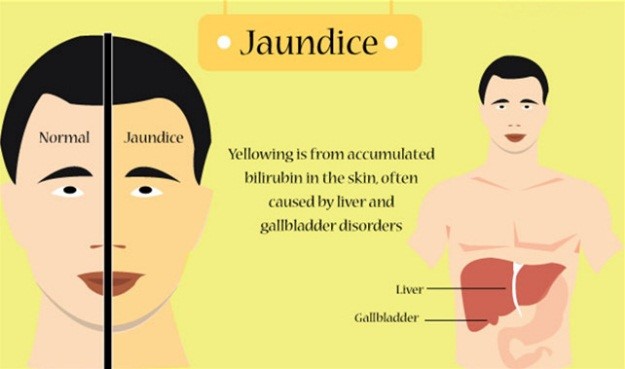Jaundice describes a condition where the skin and other parts of your body, such as the eyes, turn yellow. What causes jaundice is the accumulation of a substance called bilirubin in the body. Although bilirubin is normally produced by the body in small amounts, its accumulation in large amounts in the tissues causes yellow discoloration of the white of the eyes and the skin. This is not a normal condition and you must see a doctor to know why you have jaundice. Your treatment will depend on what is causing your condition.
Causes of Jaundice in Infants
Hyperbilirubinemia, or excess bilirubin, is the main reason why someone develops jaundice. The yellow color is from the bilirubin pigment, which is released when old red blood cells are broken down. This is normally filtered by the liver and is released into the intestines for excretion.
A newborn baby has an immature liver, which may not be able to remove bilirubin immediately, thus causing the accumulation of bilirubin and yellowing of the skin. This condition is called physiologic jaundice, which is normal for some newborn babies. This typically appears on their second or third day after birth, and disappears without medical treatment.
Other Causes
Some infants are jaundiced from the day they are born, or sometimes much later than the third day after birth. In these infants, an underlying disorder is associated with their jaundice. Diseases that can cause non-physiologic jaundice include:
- Hemorrhage or internal bleeding
- Sepsis or infection in the baby's blood
- Viral/bacterial infection
- The mother's blood type is incompatible with the baby's blood type
- Liver malfunction
- Enzyme deficiency
- The baby has abnormal red blood cells
Causes of Jaundice in Adults
1. Conditions Related with the Red Blood Cells
 An increase in the rate of breakdown of the red blood cells usually results in increased bilirubin production, which may circulate in the bloodstream. Liver cells are not able to keep up with the pace to process excess bilirubin, resulting in build-up and spillage in the blood. Conditions that lead to an increased red blood cell breakdown include:
An increase in the rate of breakdown of the red blood cells usually results in increased bilirubin production, which may circulate in the bloodstream. Liver cells are not able to keep up with the pace to process excess bilirubin, resulting in build-up and spillage in the blood. Conditions that lead to an increased red blood cell breakdown include:
- Genetic conditions such as thalassemia, sickle cell anemia, G6-PD deficiency, and spherocytosis
- Malaria
- Hemolytic uremic syndrome
2. Conditions Related with the Liver Cells
Conditions involving your liver cells may cause build-up of excess bilirubin. You may have a liver enzyme deficiency, an obstruction to the flow of bilirubin from the liver to the bile ducts, or a problem with damaged liver cells. These conditions may result in poor processing of bilirubin, which may spill into the bloodstream to cause jaundice. Liver cell problems that may cause abnormal bilirubin production include:
- Hepatitis or liver inflammation, which may be caused by an infection, alcohol abuse, autoimmune disorder, poisoning, or a side-effect of certain medications.
- Cirrhosis or scarring of the liver (fibrosis), which is a slow, progressive condition that does not cause early symptoms, but leads to jaundice when liver function is severely affected.
- Rare hereditary defects in liver enzymes involved in processing bilirubin, such as Gilbert's syndrome, Crigler-Najjar syndrome, Rotor's syndrome, and Dubin-Johnson syndrome.
3. Conditions Related with the Tiny Bile Ducts
The liver has small bile ducts that allow passage of bile, containing bilirubin, for excretion. If these bile ducts are narrowed or damaged, bile flow becomes restricted. Bile spills into your bloodstream, leading to jaundice. Primary biliary cirrhosis and primary sclerosing cholangitis are examples of bile duct problems.
4. Conditions Related with the Common Bile Duct
From the bile ducts, bilirubin-containing bile drains from the liver into your common bile duct (CBD). Obstruction of the CBD causes excess bile to join the bloodstream, leading to jaundice. Conditions that cause obstructive jaundice include:
- Gallstone formation, which may occur in the gallbladder, but gallstone get stuck in the CBD
- Cancer in the pancreas
- Pancreatitis, or inflammation of the pancreas, causing swelling of the organ
- Biliary atresia, a condition where inflamed bile ducts become fibrotic (scarred)
- Gallbladder cancer
Causes of Jaundice in Pregnancy
- Cholestasis of pregnancy. This uncommon condition, which occurs during the last trimester, usually affects women from Chile and Scandinavia, and tends to occur with every pregnancy. It is also associated with the use of oral estrogens. Women with this condition experience severe itchiness and may have an increased risk of developing gallstones. Fetal developmental abnormalities are also possible.
- Pre-Eclampsia. This condition is characterized by high blood pressure, increased fluid retention, anemia, and kidney damage. Destruction of red blood cells increases bilirubin levels, but jaundice is not common.
- Acute fatty liver of pregnancy. This is a very serious complication associated with pre-eclampsia. It results in liver failure, but delivery of the fetus may reverse it. Jaundice may occur, but not in all patients. Infant death is also a possible risk.
Prevention of Jaundice
Jaundice may be prevented by avoiding the underlying cause. These include:
- Avoiding heavy use of alcohol use to prevent alcoholic hepatitis, pancreatitis, or cirrhosis
- Getting vaccinations for hepatitis A and hepatitis B
- Taking medications to prevent malaria before traveling to high-risk areas
- Avoiding high-risk behaviors (drug abuse or unprotected sex, which can cause hepatitis B)
- Avoiding potentially contaminated water or food, and maintaining good hygiene to prevent hepatitis A
- Avoiding toxic medications or substances that may cause hemolysis (breakdown of red blood cells) or liver damage
Watch the video to have a general idea on treatments of jaundice:
